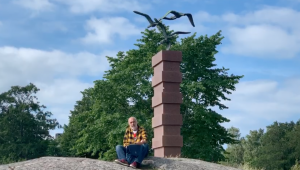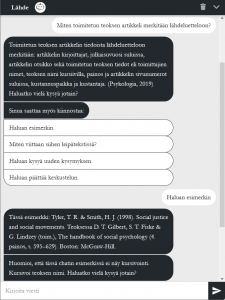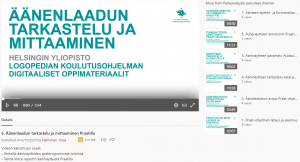Olen Katja Hätönen ja aloitin Human Nutrition and Food Related Behavior (HNFB) -maisteriohjelman digiloikan projektisuunnittelijana elokuun alussa. Olen työskennellyt useamman vuoden ravitsemustieteen opettajana Avoimessa yliopistossa, jossa karttui kokemusta Moodlesta ja etäopetuksesta. Antoisana koen sen, että minulla on tuttuja kollegoja niin ravitsemustieteen osaston, Avoimen yliopiston kuin opetusteknologian puolella. Yhteistyössä on voimaa!
Suureellisesti liikkeelle: digiryhmätöitä massakurssilla
Tavoitteenamme on
- osallistaa opiskelijoita digiaineistojen tuottamiseen ja vertaisarviointiin
- yhteistyön tiivistäminen Avoimen yliopiston kanssa.
Tavoitteita lähdettiin heti edistämään HNFB-111 Anatomian ja fysiologian -perusteet kurssilla. Kurssille osallistuu noin 320 opiskelijaa, joista Avoimen opiskelijoita on 20. Opiskelijat tekevät ryhmässä videoklipin, joka vertaisarvioidaan Moodlen työpaja-aktiviteetilla. Lisäksi kehitetään itseopiskelutehtäviä ja verkkotenttiä.
Ryhmätyön suunnittelu yhteistyönä
Arvioimme, että ryhmiä tulisi muodostumaan yli 70. Oli selvää, että erilaista osaamista niin verkkopedagogiikassa kuin Moodlen salojen ymmärtämisessä tarvittaisiin. Lähdimme yliopisto-opettaja Eeva Voutilaisen (MMTDK ja Avoin yliopisto) kanssa ideoimaan ja kokeilemaan vaihtoehtoisia tapoja toteuttaa videon tekoa verkkoympäristössä, arviointitapojen vaihtoehtoja sekä teknisiä mahdollisuuksia; arvokasta tukea ja innostusta saimme seuraavilta
- asiantuntija Nina Dementjeff (Avoin yliopisto)
- koordinaattori Margit Koivumaa (Yliopistopalvelut)
- verkkopedagogiikan asiantuntijat Outi Valkama ja Kristian Lindqvist (Yliopistopalvelut).
Testialueet suunnittelun tukena
Ennen kurssin alkua Margit Koivumaa loi testialueen Moodleen ja Teamsiin, jossa kokeilimme käytössä olevia digityökaluja, esimerkiksi
- Teamsillä ja Zoomilla teimme videoita, jotka latasimme Moodleen; keskustelualueelle on mahdollista lisätä video, jonka koko on korkeintaan 50 Mt
- kokeilimme Moodlen arviointityökaluja.
Keskustelualueen arvioinnissa näkyviin jäi vain sen opiskelijan arviointi, joka oli tehty viimeisenä. Tavoitteena oli löytää menetelmä, joka laskisi keskiarvoja opiskelijoiden tekemistä arvioinneista. Tämän vuoksi päädyttiin työpaja-aktiviteettiin, jossa hyödynnettiin Avoimen yliopiston ravitsemustieteen kursseilla hyväksi havaittua arviointimatriisia.
Työpaja-aktiviteetti vaatii enemmän etukäteistyötä opettajalta kuin keskustelualueen hyödyntäminen arvioinneissa. Huolellisella valmistelulla työpaja-aktiviteetti on kätevä työkalu, joskin se soveltuu paremmin yksilö- kuin ryhmätyöskentelyyn. Siksi opiskelijat tekevät suunnitelmista poiketen itsenäisesti vertaisarvioinnin työpaja-aktiviteetilla.
Ryhmätyö käynnistynyt hyvin massakurssilla
Opiskelijat ovat aktiivisesti ryhmäytyneet ja tekevät tällä hetkellä käsikirjoituksiaan; osa ryhmistä valmistelee jo videoita; ensimmäiset ovat videonsa jo palauttaneet. Marraskuun alkupuolella näemme, miten vertaisarviointi onnistuu työpaja-aktiviteetilla näin suurella kurssilla.
Itseopiskelutehtävien lisääminen videoihin H5P-toiminnolla
Anatomian ja fysiologian perusteet -kurssille oli jo aiemmin kerätty opiskelun tueksi videoita YouTubesta. Näihin videoihin aloitin tekemään H5P-toiminnolla monivalintakysymyksiä, joiden avulla opiskelijat voivat testata oppimaansa. Tehtävät on määritelty niin, ettei videon katsomista pysty jatkamaan ennen kuin kaikkiin kysymyksiin on vastattu oikein.
Kurssilla kootaan palautetta tehtävistä. Onkin hienoa nähdä, mitä mieltä opiskelijat ovat interaktiivisista videoista ja mitä kehitysideoita saamme. Syksyn Pedaforumin (2020) esitysten perusteella vastaanotto opiskelijoiden keskuudessa on ollut myönteinen interaktiivisia videoita kohtaan ja niiden on koettu tukevan oppimista.
Säännölliset kokoukset ohjausryhmän kanssa
Digihankkeen käynnistimme elokuussa siirtolapuutarhamökillä ravitsemustieteen opettajien kanssa (Mikael Fogelholm, Maijaliisa Erkkola, Riitta Freese, Tiina Jääskeläinen, Liisa Korkalo, Anne-Maria Pajari ja Eeva Voutilainen). Toinen tapaaminen pidettiin lokakuun alussa Teamsissa; esittelin, miten digiloikka on käynnistynyt, vaihdettiin ajatuksia, jaettiin kokemuksia ja unelmoitiin tulevasta. Parhaat ideat syntyvät, kun niille annetaan tilaa ja aikaa! On hienoa nähdä ravitsemustieteen digiloikan etenevän suunnitellusti.




